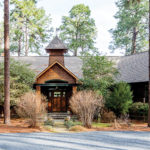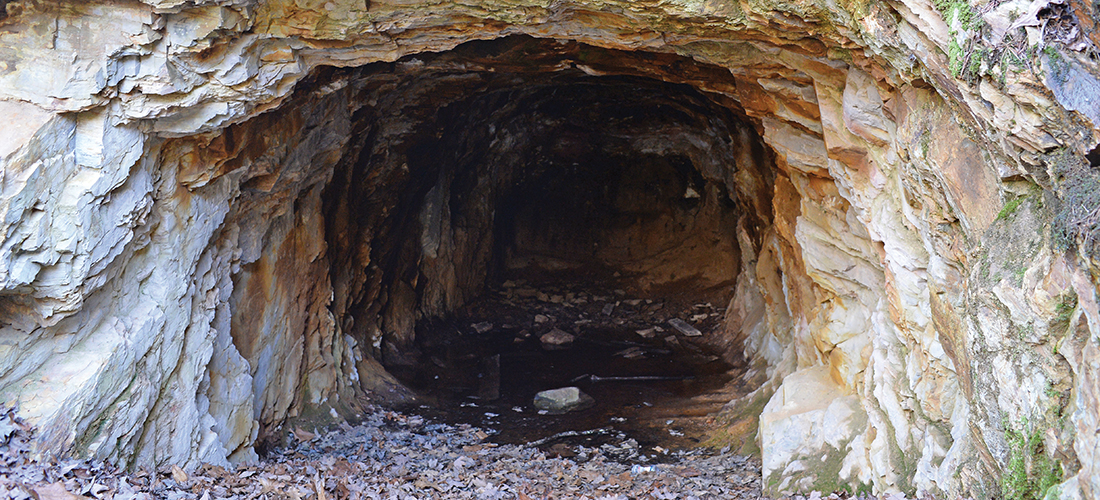
Deep in the Sandhills, a lingering legacy of dreams
By Bill Fields
On a January morning that would soon warm up so that a sweater was plenty for a hike in the woods, I was off to look for gold — or at least look for a place where men used to look for gold.
My guide, Donnie Reeves, who has studied and explored Montgomery County’s gold heritage for more than three decades, led me in his pickup to a pull-in for the Uwharrie National Forest north of Troy. At the urging of his father he had wanted to seek his fortune in Alaska but never made the long trip. Instead, after becoming fascinated with the story of gold much closer to his native Alamance County, he made a much shorter journey.
“I lived in an old school bus for two years — me, my wife and children,” Reeves says. “My mother and daddy bought themselves a school bus and they came right behind me. We lived in that bus for two years and prospected when we could. We loved the area and never left.”
As I parked my rental car next to Reeves’ truck a few miles from his current home down the road from an old Methodist Church, I was not only excited about my forthcoming tour of the site of the former Russell Gold Mine, but also thinking about how my roots intersected with North Carolina’s 19th century gold rush, which predated California’s and was the exclusive supplier of domestic gold for the United States Mint from 1804 to 1828.
Many people were drawn to the Carolina slate belt, a series of rocks 25 to 70 miles wide extending from the South Carolina to Virginia borders for the potential riches — or more realistically, a job — in the 1800s. Lockey Arnold Henderson, my great-grandfather, who was born in 1818, left Chatham County on horseback as a young farmer. He headed for the Montgomery County village of Eldorado, the Old North State’s twist on El Dorado, the mythical “Lost City of Gold” in South America. (Locals pronounce a “long a” in the one-word version.) In the Uwharries, great-grandpa found work in the gold mines, settled and had a large family, including my grandfather, B.L. Henderson, who was born March 28, 1861, less than a month before the Civil War began.
“The first gold mining in North Carolina may have been by the Indians in Cherokee County before white settlers arrived,” P. Albert Carpenter III wrote in a 1993 North Carolina Geological Survey. Carpenter also notes reports that explorer Hernando de Soto attempted to mine gold in 1540 near Murphy, N.C. There were accounts of mines operating in Gaston and Mecklenburg counties before the Revolutionary War, and of the U.S. Mint receiving gold from North Carolina as early as 1793, according to Carpenter.
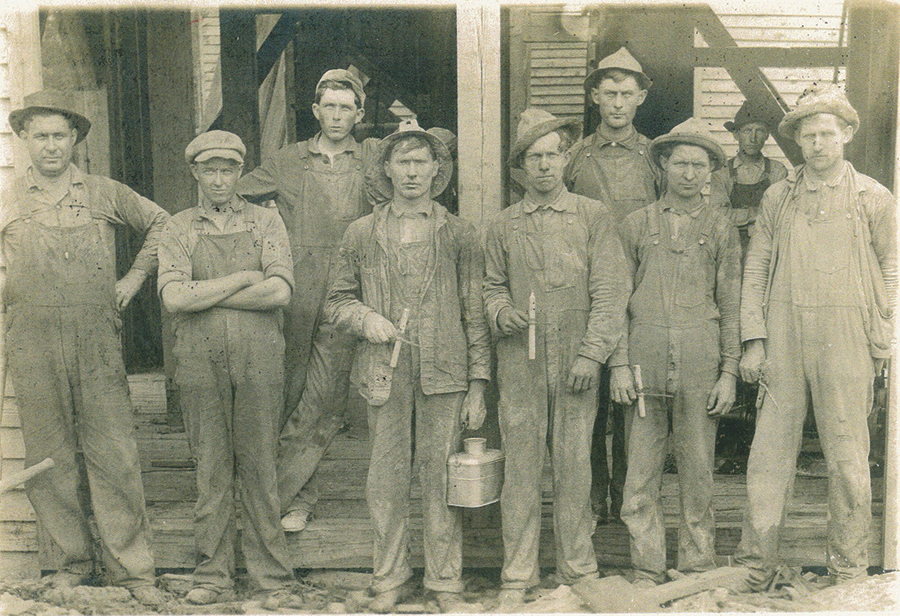
The frequently cited and “first authenticated discovery of gold” in North Carolina — and the U.S. — according to the state report, occurred in 1799 by a boy fishing in a Cabarrus County stream. But three years went by before the child’s father, John Reed, a German immigrant farmer, took the yellow, 17-pound nugget that had been used as a doorstop to a second jeweler for evaluation. Swindled by the jeweler, who paid him only $3.50, Reed eventually figured out the scam and reportedly received approximately $3,000 for Conrad Reed’s find. Reed’s Little Meadow Creek, where the first nugget came from, turned out to hold more gold and the rush had begun.
Capitalizing on the proximity of the valuable mineral, the Charlotte mint opened in 1837, producing $1, $2.50 and $5 gold coins — issuing more than $5 million worth — until it closed at the outset of the Civil War. During the 19th century, gold was discovered in a third of North Carolina’s 100 counties, with 345 mines open at one point according to state records, although other sources place the number at more than 600 during the peak years when gold mining trailed only farming as North Carolina’s biggest industry.
“Hundreds weren’t listed because they were really Mom and Pop operations,” says Reeves. “Farmers would operate them during the wintertime when they didn’t have crops to work.”
Montgomery County and Moore County each had about 20 mines, the former more of a hotbed of activity. Most of the Moore County mines were located north of Highway 24/27 southwest of Robbins. A “Gold Region” post office existed in that area from 1844 to 1866, then was renamed “Carters Mills,” for one of the mines, and operated until 1932. A “Gold Region No. 2” was open from 1877 to 1879.
A 1903 advertisement in the Pinehurst Outlook for “real estate and hunting grounds” offered by R.L. Burns of Carthage noted “fine farm, trucking peach, grape and berry lands . . . Also GOLD property.”
Moore County’s gold caught the eye of inventor Thomas Edison when he visited North Carolina in 1890. “(He) is in Moore county on a prospecting tour,” The Evening Visitor of Raleigh reported on June 25. “He is said to have taken options on large bodies of lands, rich in gold. Mr. Edison will soon form a syndicate of English capitalists and commence work, and the purchaser contemplates turning the water through it for gold-washing purposes.”
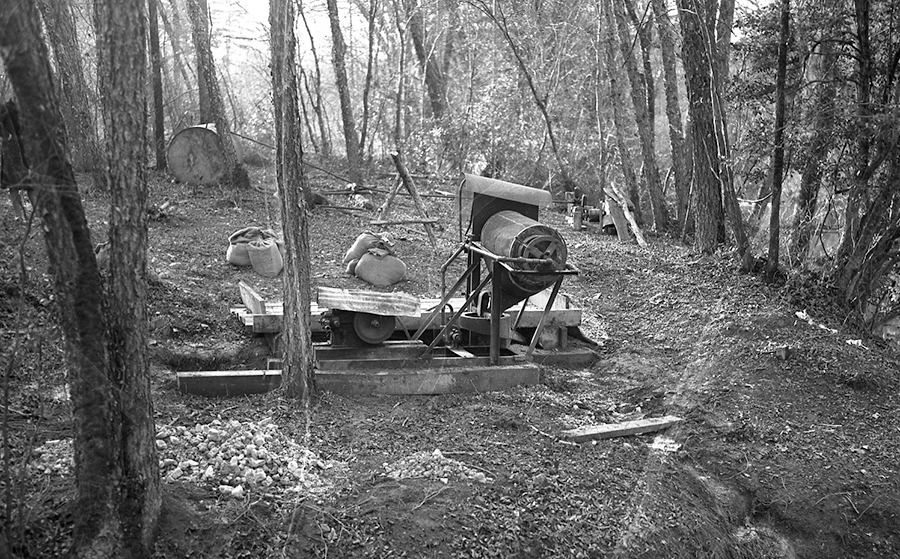
A “Gold Mine Pit” is even denoted 1 mile northeast of the Village Green on an 1897 map of Pinehurst and vicinity — likely a “prospect” where a tiny bit of gold was discovered. “They probably found a little bit of gold when they dug down but there wasn’t enough to keep digging,” Reeves says. “There are thousands of those places. More than likely, that’s what happened there.”
There were no such false starts at the Russell Mine. By the middle of the 19th century it was the biggest gold mine in Montgomery County and the subject for a detailed 1853 report from the Perseverance Mining Company projecting millions in revenue over the course of a 60-year lease on the 40 acres of mineral land.
“More than likely your great-grandfather worked in this mine,” Reeves says as we walk into the national forest and see the first sign of the Russell operation, an old 100-foot shaft with bars installed at its entrance to keep out the curious. “There were homes and shacks where the workers lived. Hundreds of people lived here. There was a general store and a hotel across the street. Forty-some miners worked on a shift, and they’d run 24 hours.”
Some gold extraction was done through placer mining, a process in which miners washed eroded ores of rocks containing gold with pans, rockers and sluices (a grated rectangular box). The other type of deposit was found underground and in open pits dug by the miners in the form of gold veins often embedded in quartz. The largest excavation on the Russell property was “The Big Cut,” a pit 300 feet long, 150 feet wide and 60 feet deep.
The ore was crushed by 190-pound “stamps” that fell the height of a man or more, pounding the gold into a fine substance. The equipment allowed a mine to process 20 to 50 tons of material daily instead of just a few tons.
“You could feel the ground shake a half mile from here because of the many stamp mills,” Reeves says, a jarring observation on such a peaceful winter day. “You could hear it miles away.”
We walk farther into the forest and encounter “The Big Cut,” now cluttered with trees and other vegetation that make it seem smaller than its working dimensions. Miners would earn less than a dollar a day for their dirty, exhausting labor. Some miners went west when gold was found in California in 1849. Many of the mines closed as they became less profitable. Most closed down for the duration of the Civil War with the exception of the Silver Hill Mine in Davidson County, which produced ammunition for the Confederate Army. Some of the bullets were not only lead but included gold and silver because wartime wouldn’t allow for a costly and lengthy separation process.

“Lot of the Yankees who came down here had gold pans strapped to their saddles. They thought they were going to come in here and get rich,” Reeves says.
Following the Civil War there was a revival in North Carolina gold mining that continued, with intermittent lulls, into the first quarter of the 20th century.
“This portion of Montgomery County is a vast gold bed,” a correspondent for The Weekly Observer in Raleigh reported in 1878 while visiting the Swift Island mine. “Many pieces of gold weighing from one to two and three pounds have been found. We saw the hole in the ground from which two pieces were taken that weighed exactly a pound and a quarter each, each piece looking just like a frog.”
Thirty years later, the Asheboro Courier noted: “Bud Morgan found a valuable nugget of gold weighing 20 ounces near Eldorado.”
The Coggins Mine, a mile northeast of Eldorado on the road to New Hope, operated off and on from 1882 to 1934 as one of the busiest in the area. It was the scene of tragedy on Jan. 15, 1914 when three miners, eager to leave work on payday, hopped into the ore bucket for the 350-foot ride to the surface instead of climbing a ladder.
“They wanted to beat everybody else out of the mine,” Reeves says. “When it got to the top, the bucket hung on a ledge and flipped over and they fell to their deaths.”
Lizzie Sanders, wife of one of the three men, Walter Sanders, was in her home at the time. “The whistle at the mine started blowing,” Lizzie recalled decades later in an interview with the Montgomery County Historical Society. “Sometimes, they’d just give it a puff or two. But this time it just kept on and on.” Presently Lizzie found out how serious the accident was, fainting upon hearing the news.
According to the N.C. Geological Survey, total gold production in the state is approximately 1.1 million ounces, worth an estimated $25 million at historical prices. At current prices of $1,230 an ounce, it would be worth $1.24 billion.
“In the 1980s and ’90s I worked for a number of gold mining companies that came in here and investigated, trying to see if any of the old mines were worth mining,” Reeves says. “We did rock samples, but it would be too expensive to mine. We know there is over 20,000 ounces in the ground, but those companies were looking for a million-dollar deposit.”
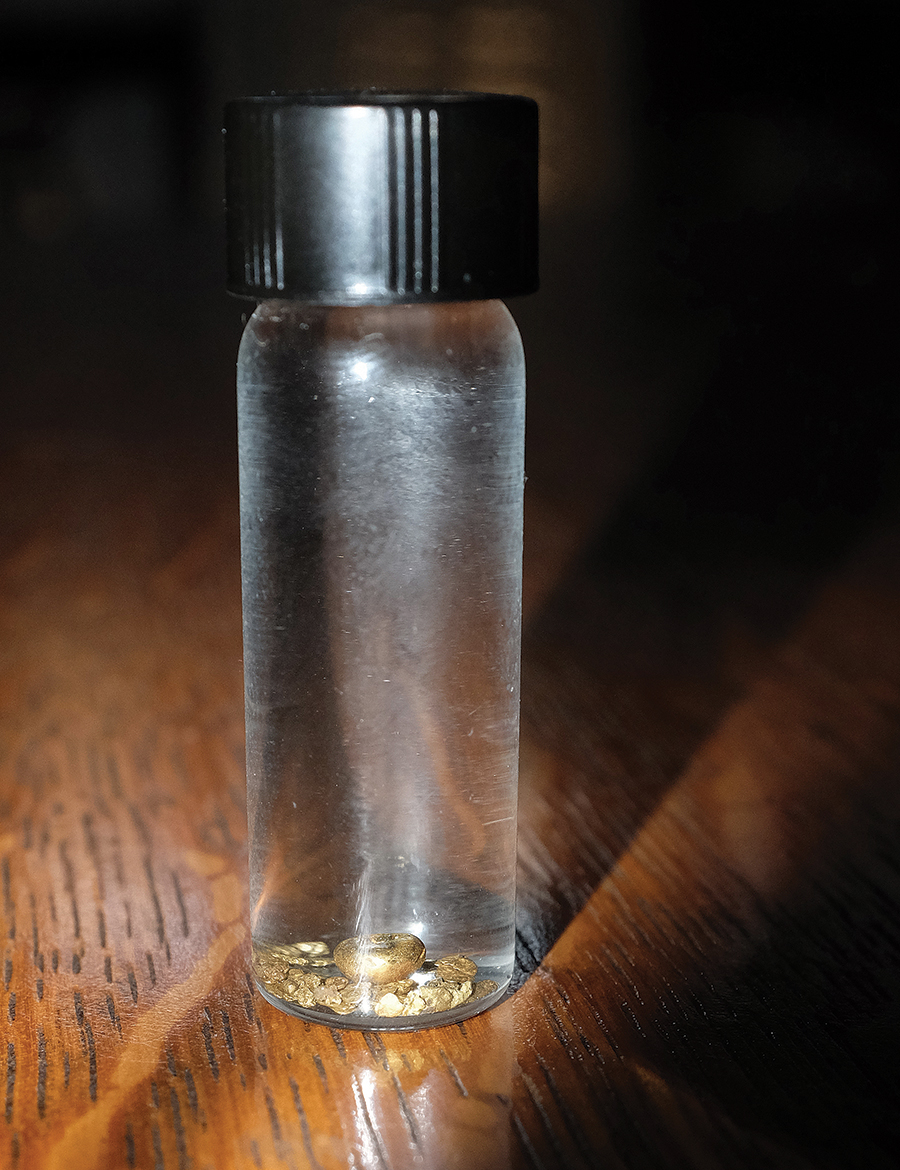
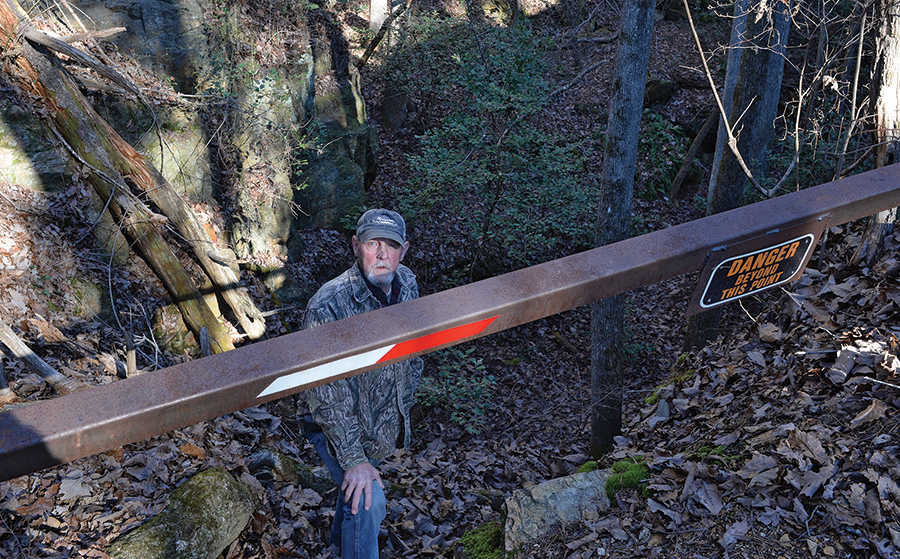
Scores of people come to Montgomery County annually to pan and sluice for gold. Reeves has spent a lot of his time educating the recreational panners how to do it. While we were talking in his kitchen, Reeves gave me a small water-filled vial containing about a dozen small flakes and a nugget the news of which wouldn’t make the newspaper. This gold came from a nearby creek.
“When it gets to the size of the biggest one in there and you drop it in your gold pan and it you hear it go ‘clunk,’” he says, “it’s a nugget.” My gold is only worth a few dollars but he warns me not the shake the vial. “That gold is heavy enough to knock the bottom out,” he says, providing another example why so many went through so much for so long in pursuit of the element.
After our trek to the former Russell property, I had one other request of Reeves. There was another mine site in the Eldorado area I wanted to see.
We arrive at a 21st century general store and ask the owner if she can contact the owner of an adjacent parcel of land. A call is made and permission is granted. In a few minutes we’re maneuvering through trees and dead leaves about 100 yards east of Highway 109.
“There it is,” Reeves says, when we come to a clearing and a water-filled hole of about 10-by-10 feet. “That’s the Henderson Mine.”
My middle name, possibly some of my relatives.
Nearly a century ago, it had been a working shaft of 40 or 50 feet deep. Now, there was the reflection of the blue sky on the accumulated water. The way the light was hitting the old mine, there was a bit of a golden hue on the surface. I took a few photographs and began walking toward the car.
“Just a hole now,” Reeves said.
This mine was history, maybe even some of my own. PS

